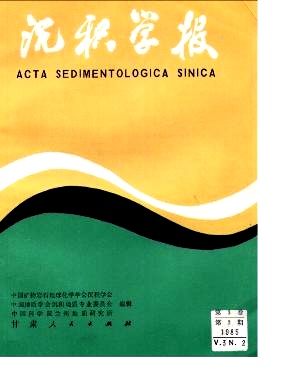MINERALOGY OF HIGH ALUMINA CLAY-BAUXITE DEPOSITS IN SHANXI AND HENAN PROVINCES
- Received Date: 1984-02-25
- Publish Date: 1985-06-10
Abstract: In technology field the refractory clays with Al2O3 46% are called high alumina clays among which Al/Si≥2.6 is called bauxite.Paleozoic high alumina clay-dauxite deposits are aboundant in China. They are mainly distributed in Shanxi and Henan provinces. It is known that there are more than 100 occurrences of high alumina clay-bauxite deposit in the two provinces. Their reserve is about several hundred million tons.Almost all of high alumina clay-bauxite deposits in the two provinces occur at the lower part of the Middle Carboniferous series which overlay the Middle Ordo-vician series limestone as uncomformity.This paper suggests that the material sources of the deposits are mainly the products of weathered aluminium silicates on the peneplainized continent under hot and humid climate(i.e.colloform of Al protected by humic acid or colloidal solution of Al.Ti.Fe.Si, gel of Al in form of suspension,kaolinite, hydromica and detritus of heavy minerals). The next is the minor weathered residues of carbonte derived from some rises. Both of the products and residues were transported by braided rivers. Most of them deposited in lakes and very few in swamps. During the sedimentation the ore was generally in gel, oolite or fragmental texture, Indicating colloid-mechanical mixed deposition. In the diagenetic process diaspore, chlorite and pyrite were formed under redu-ction and alkaline conditions; and diaspore or boehmite and kaolinite under acidcondition.In the epigenetic process diaspore and kaolinite were recrystallized and ordered as temperature and pressure increased. Diaspore was formed by desilication of kao-linite under alkaline condition. Kaolinite could be converted to dickite or diaspore to which silica was added was converted into dickite under acid condition. Also diaspore to which silica was added turned into kaolinite and prophyllite under acid condition.At the late stage kaolinite and other clay minerals were desilicated and became gibbsite due to the leaching of some organic acid, sulpuric acid produced by some weathered pyrite and carbonic acid. At the same time, high alumina clay-bauxite deposits were getting higher in quality as Fe and Ti were removed. Under acid condition of water media and with the existence of proper content of SiO2 solution kaolinite, galapectite and other clay minerals were formed by filling and replacement at the active of underground water. On the contrary, under alkaline condition and with the existence zone of some alkaline or alkaline-earth metal cation, hydromica, montmorillonite, mixed layer of chlorite-vermiculite and mixed layer of hydromica-montmorillonite were also formed by the same two actions, so that the quality of the high alumina clay-bauxite deposits was getting worse.By late weathering and leaching the ore became porous and honeycomb-like due to the leaching out of pyrite or became pale, because of the oxidazation of a small amount of contaminated organic matters. However, the weathering and leaching which were beneficial to the raise of ore quality are oftn neglected.The following heavy minerals are of terrigenous elastics: zircon, rutile, ilmen-ite, tournaline, magnetite, anatasc, brookite, sphene, leucoxene, pyroxene quartz garnet, gahnite,monacite, xenotime,epidote and so on, the epigen'etic minerals are anatase,zircon, rutile,magnetite and corundum.In addition, another two kinds of high alumina clay deposits occur in theUpper Carboniferous stratigraphy of North Shanxi.1. Humic acid leaching type: This kind of deposits is mainly formed during dia-genesis. Silica and other impurities in clay bed and the top part of coalseam were leached away by humic acid. The dominant mineral is kaolinite next to it are boe-chmite and so on. The deposits in Huairen district are big in size. The ore is a kind of light-grey and black-grey, dense(fine grained) high alumina clay. The content of harmful impurities is very low. It is valuable in industry though the ratio of A/S is lower.The deposits in Baode district are small in size. The ore is purer. The dominant mineral is coarse myrme
| Citation: | Liu Changling, Shi Zichen. MINERALOGY OF HIGH ALUMINA CLAY-BAUXITE DEPOSITS IN SHANXI AND HENAN PROVINCES[J]. Acta Sedimentologica Sinica, 1985, 3(2): 18-36. |






 DownLoad:
DownLoad: